

Gene acts as a brake on breast cancer progression. New research out of McGill University's Goodman Cancer Research Centre provides compelling new evidence that a gene known as 14-3-3σ plays a critical role in halting breast cancer initiation and progression.
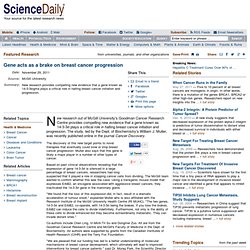
The study, led by the Dept. of Biochemistry's William J. Muller, was recently published online in the journal Cancer Discovery. The discovery of this new target points to novel therapies that eventually could slow or stop breast cancer progression. New study shows biopsy of recurrent breast cancer can alter treatment. A second, larger clinical research study led by breast cancer specialists at Princess Margaret Hospital (PMH) has again proven that comparing a new biopsy of progressing or recurring cancer with that of the original cancer can dictate a change in treatment.
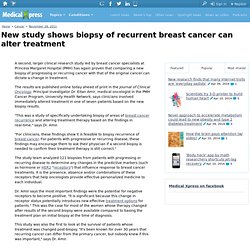
The results are published online today ahead of print in the Journal of Clinical Oncology. Principal investigator Dr. Eitan Amir, medical oncologist in the PMH Cancer Program, University Health Network, says clinicians involved immediately altered treatment in one of seven patients based on the new biopsy results. Diabetes drug shows promise in reducing risk of cancer, study suggests.
An inexpensive drug that treats Type-2 diabetes has been shown to prevent a number of natural and human-made chemicals from stimulating the growth of breast cancer cells, according to a newly published study by a Michigan State University researcher.
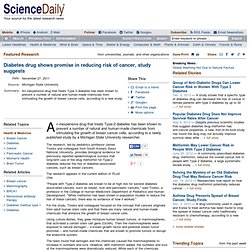
The research, led by pediatrics professor James Trosko and colleagues from South Korea's Seoul National University, provides biological evidence for previously reported epidemiological surveys that long-term use of the drug metformin for Type-2 diabetes reduces the risk of diabetes-associated cancers, such as breast cancers. The research appears in the current edition of PLoS One. "People with Type-2 diabetes are known to be at high risk for several diabetes-associated cancers, such as breast, liver and pancreatic cancers," said Trosko, a professor in the College of Human Medicine's Department of Pediatrics and Human Development.
The team found that estrogen and the chemicals caused the mammospheres to increase in numbers and size. Researchers find genetic rearrangements driving 5 to 7 percent of breast cancers. Researchers at the University of Michigan Comprehensive Cancer Center have discovered two cancer-spurring gene rearrangements that may trigger 5 to 7 percent of all breast cancers.
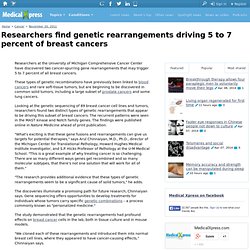
These types of genetic recombinations have previously been linked to blood cancers and rare soft-tissue tumors, but are beginning to be discovered in common solid tumors, including a large subset of prostate cancers and some lung cancers. Looking at the genetic sequencing of 89 breast cancer cell lines and tumors, researchers found two distinct types of genetic rearrangements that appear to be driving this subset of breast cancers. The recurrent patterns were seen in the MAST kinase and Notch family genes. The findings were published online in Nature Medicine ahead of print publication.
"The research provides additional evidence that these types of genetic rearrangements seem to be a significant cause of solid tumors," he adds. The discoveries illuminate a promising path for future research, Chinnaiyan says. A new molecular mechanism in breast cancer development. About 10% of breast cancers are due to mutations in genes called BRCA1 and BRCA2.

However, the molecular mechanism by which alteration of these genes greatly increases the risk of cancer is not fully understood. In a new study, published Nov. 15 in the online, open-access journal PLoS Biology, an international team led by Miquel Àngel Pujana, of Bellvitge Biomedical Research Institute (IDIBELL) and the Catalan Institute of Oncology (ICO), and Christopher Maxwell, now at the Child and Family Research Institute, has made an important step towards revealing the underlying pathways. The researchers found a key interaction between BRCA1 and another protein called RHAMM (encoded by the HMMR gene). These two proteins act on a previously unknown molecular mechanism that regulates epithelial cell polarity.
The researchers have shown that BRCA1 and RHAMM control the normal development of breast epithelial cells. Alcohol consumption by adolescents may increase breast cancer risk in those with a family history of the disease. Neurological and executive function impairment associated with breast cancer. Women who survive breast cancer show significant neurological impairment, and outcomes appear to be significantly poorer for those treated with chemotherapy, according to a report in the November issue of the Archives of Neurology.

Breast cancer (BC) is one of the most common public health problems, with a worldwide estimated incidence of 39 per 100,000 individuals annually. Although primary BC has not been associated historically with neurological problems, a growing body of evidence suggests that patients are at increased risk for altered brain structure and function, according to background information in the article. Shelli R. Kesler, Ph.D., and colleagues at Stanford University School of Medicine, Stanford, Calif., conducted an observational study to determine whether profiles of brain activation differ among BC survivors treated with or without chemotherapy, compared with healthy control women. Benefit of novel drug in breast cancer seen in blood within weeks. Public release date: 13-Nov-2011 [ Print | E-mail Share ] [ Close Window ] Contact: Jeremy MooreJeremy.Moore@aacr.org 215-446-7109American Association for Cancer Research SAN FRANCISCO — Clinical benefit from use of a novel histone deacetylase inhibitor drug may be determined by examining blood cells days after a patient receives treatment.
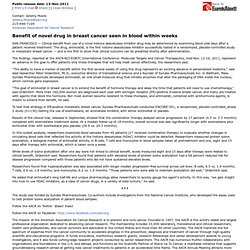
The drug, entinostat, is the first histone deacetylase inhibitor successfully tested in a randomized, placebo-controlled study in metastatic breast cancer — and is the first to show that clinical outcome can be predicted shortly after administration. The findings, reported at the AACR-NCI-EORTC International Conference: Molecular Targets and Cancer Therapeutics, held Nov. 12-16, 2011, represent an advance in the goal to offer patients only those therapies that will help treat cancer effectively, the researchers said. He added that entinostat's long half-life and unique pharmacology allow researchers to quickly gauge the agent's activity.
Signaling pathway linked to inflammatory breast cancer may drive disease metastasis. Tamoxifen Resistance – and How to Defeat It. Newswise — In the last three decades, thousands of women with breast cancer have taken the drug tamoxifen, only to discover that the therapy doesn’t work, either because their tumors do not respond to the treatment at all, or because they develop resistance to it over time.

Now researchers at the University of California, San Francisco (UCSF) have discovered the molecular basis for tamoxifen resistance and found a potential way to defeat it. On Sunday, Nov. 13, 2011, at the AACR-NCI-EORTC International Conference: Molecular Targets and Cancer Therapeutics, UCSF oncologist Pamela Munster, MD, and her colleagues will present the results of clinical studies and laboratory experiments that show how some tumors resist tamoxifen and how this resistance can be overcome by administering a second class of drugs. Study helps eliminate causes for joint pain linked to commonly used breast cancer drugs. Public release date: 11-Nov-2011 [ Print | E-mail Share ] [ Close Window ] Contact: Karen Malletkm463@georgetown.edu Georgetown University Medical Center Washington, D.C. – Researchers exploring why some women who take a common breast cancer drug develop serious joint pain have eliminated two possible causes: inflammatory arthritis and autoimmune disease.

Because of these findings, researchers say women should be encouraged to continue taking the medication to gain its full benefit. New target identified to stop the spread of breast cancer. A new potential target to slow breast cancer tumor progression and metastasis has been identified by a team of researchers led by Dr.

Richard Kremer from the Research Institute of the McGill University Health Centre (RI-MUHC). Complications in breast cancer patients are commonly caused by the spread of the disease through metastasis to other parts of the body, most often to the bones and lungs. These findings, published this week in the Journal of Clinical Investigation (JCI), suggest that a specific protein plays a key role in the progression of the disease outside of the initial tumor area.
Researchers showed that this particular target called parathyroid hormone-related protein (PTHrP), present at high levels in cancers, is involved in key stages of breast cancer initiation, progression and metastatic spread. In order to bring this strategy one step closer to the patient, Dr. Study Details This paper was co-authored by Jiarong Li, Dao C. Computer trained to evaluate breast cancer. Since 1928, the way breast cancer characteristics are evaluated and categorized has remained largely unchanged. It is done by hand, under a microscope. Pathologists examine the tumors visually and score them according to a scale first developed eight decades ago. These scores help doctors assess the type and severity of the cancer and, accordingly, to calculate the patient's prognosis and course of treatment. In a paper published Nov. 9 in Science Translational Medicine, computer scientists at the Stanford School of Engineering and pathologists at the Stanford School of Medicine report their collaboration to train computers to analyze breast cancer microscopic images.
The computer analyses were more accurate than those conducted by humans. Their model is called Computational Pathologist, or C-Path, a machine-learning-based method for automatically analyzing images of cancerous tissues and predicting patient survival. Related News C-Path, in fact, assesses 6,642 cellular factors.